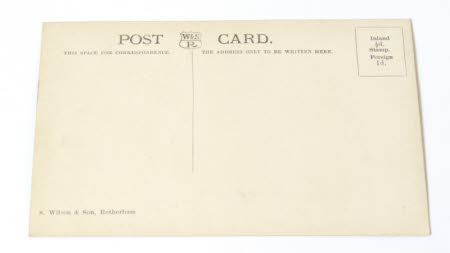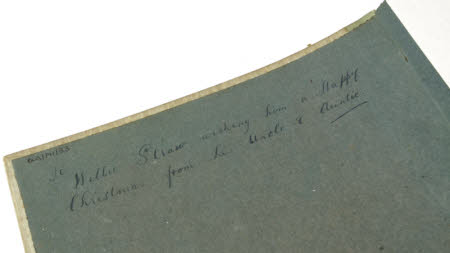Steetley Church. 635. S.W.S. R.
Category
Ephemera
Date
Unknown
Materials
Paper
Order this imageCollection
Mr Straw's House, Nottinghamshire
NT 746155.9
Summary
Postcard - Steetley Church 635.S. W. S. R. Printed on the back in black ink, centred at the top is 'POST CARD', divided by a small shield inside which reads at the top 'W&S', and beneath 'R'. Underneath this on the left 'THIS SPACE FOR CORRESPONDENCE.', and on the right, divided by a vertical printed line, 'THE ADDRESS ONLY TO BE WRITTEN HERE.' The postage box in the top right corner has the printed text 'Inland 1/2d. Stamp. Foreign 1d.'. At the bottom left of the post card is the printed text 'S. Wilson & Son, Rotherham' Pictured here is the interior of the church, the altar is seen in the background beyond the dividing arch, from the perspective of the nave.The Church is a Norman example built by one of the Le Britons around 1150 - 1160, who was married to Robert le Vavasour Lord of Steetley and Denaby, near Mexbro'. Anker Freshville in 1391 died amongst his property showed a bovate of land at Steetley with the Church that he held for services to John le Vavasour. The property continued long in the family of Freshville, some of whom resided at the hall near the Chapel, now used as a farm-house. From that family it passed into the hands of Sir Thomas Wentworth, and from his representatives to the Earls of Shrewsbury and the noble house of Howard, with whom it remained till, together with the Worksop Manor Estate, it was sold to the Duke of Newcastle. It consists of a nave and chancel, terminating in an apse, the whole being 56 feet long, divided from each other by an arch. The apse, which is semi-circular, is separated from the remainder by a second arch.
Provenance
Straw collection bequeathed to The National Trust on the death in 1990 of William Straw.




